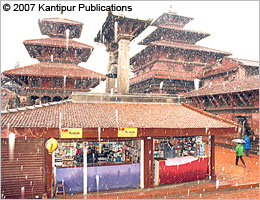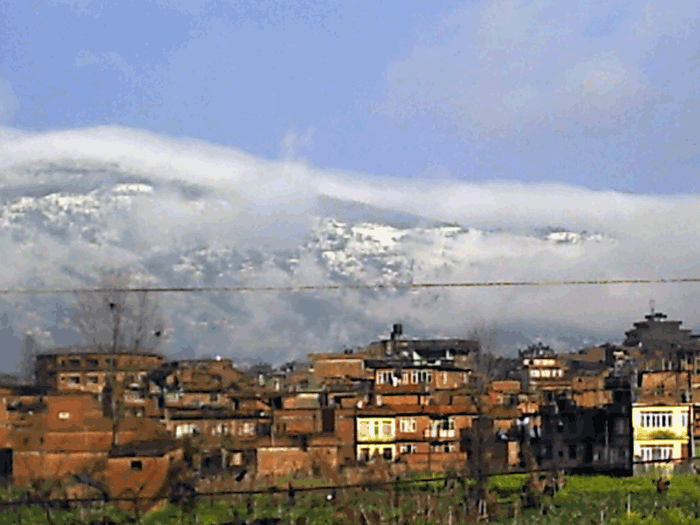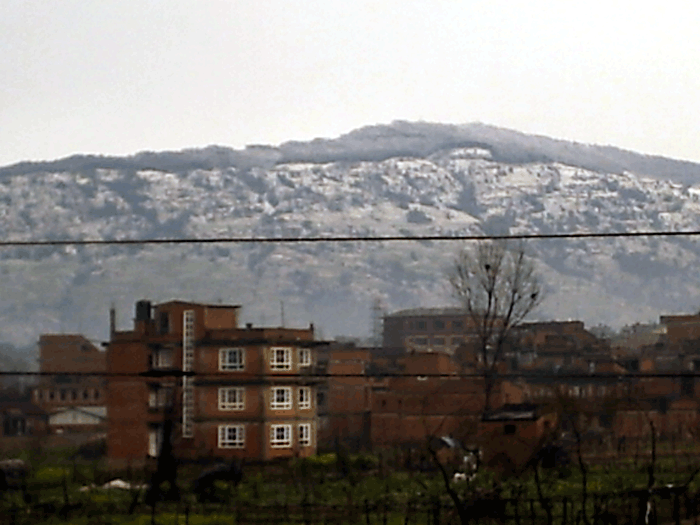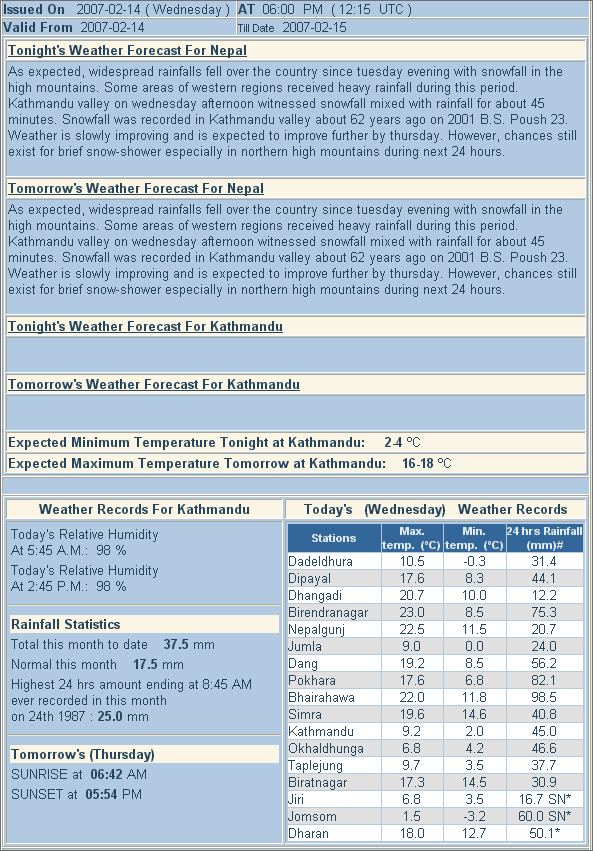|
[VIEWED 10892
TIMES]
|
SAVE! for ease of future access.
|
|
|
|
symlyn

Please log in to subscribe to symlyn's postings.
Posted on 02-14-07 4:29
AM
Reply
[Subscribe]
|
Login in to Rate this Post:
0  ?
? 
|
| |
Kathmandu ma snowfall bhayechha...Seriously Climate is changing!!! ;o) http://www.himalkhabar.com/front/morenews.php?id=1909
|
| |
|
|
|
|
Foe_4_mysty

Please log in to subscribe to Foe_4_mysty's postings.
Posted on 02-14-07 4:46
AM
Reply
[Subscribe]
|
Login in to Rate this Post:
0  ?
? 
|
| |
The content does not exists. Choose another content. F O B!
|
| |
|
|
sabbu

Please log in to subscribe to sabbu's postings.
Posted on 02-14-07 4:52
AM
Reply
[Subscribe]
|
Login in to Rate this Post:
0  ?
? 
|
| |
Kathmandu ma snow fall after 62 yrs Rain, snowfall across nation; Kathmandu sees brief snowfall after 62 years Kantipur Report KATHMANDU, Feb 14 - Various parts of the nation on Wednesday saw snowfall for the first time in the wake of the climate change gripping the nation due to continued downpour of the last couple of days. Likewise, Kathmandu residents received visual treat on Wednesday as some parts of the valley was graced by the first snowfall in 62 years. The last snowfall had occurred in January 6, 1944 when one ft of snow had covered the capital, senior meteorologist Krishna Bhakta Manandhar said. If rainfall continues tonight, Kathmandu will be covered in snow the following morning, Manandhar said adding that the snow and rainfall, which was a result of the westerly winds' low pressure line, was a normal phenomenon and will improve from tomorrow. Moreover, the west winds are shifting east and their effects are gradually becoming less visible in the West. The temperature inside the valley was 7 degree Celsius in the morning which plummeted to 3 degrees later in the day. Just as the Kathmanduites were beginning to relish the sight of soft flakes of snow, the snowfall stopped just as abruptly as it had arrived, lasting just about five minutes at around Airport, Balaju, New Road, Baneshwor, Teenkune, Bhaktapur, Godavari, Jawlakhel, Lagankhel, among others. Likewise, hilltops in the outskirts of Kathmandu including Shivapuri, Phulchowki, Nagarkot, Nagarjun, Lakhuribhanjyang were also under a three-foot-thick blanket of snow today. Dhulikhel in Kavre district is also under one feet of snowfall in some 40-45 years while Dolakha, Rasuwa, Solukhumbu, Palpa, Kalikot, Sankhuwasabha, Parbat also experienced "historic" snowfalls. The roads in the snow covered areas were obstructed while telephone and electricity services were also halted by the snowfall. In the last 24 hours, Bhairahawa experienced highest rainfall of 98.5 mm. Likewise, Birendranagar received 92.3 mm, Pokhara 79.9 mm rain while Kathmandu received some 20mm rain. Meanwhile, areas in Sankhuwasabha and Parwat experienced 2 to 3 ft of snow with Parwat locals claiming today's snowfall to be the first time in the history of the hilly district. Likewise, high altitude areas in Dolakha also experienced snowfall. Life in the Kharidhunga and Hawadanda stretch of the Lamosangu-Jiri road was disrupted due to the snowfall. Kalinchowk, Hanumante Danda and other tourist spots in the district too were snowed in. Ilam and Panchthar districts in the east also saw heavy snowfall today. Two and half ft snow has covered the entire stretch between Paanchthar's Pauwabhanjyang in the Mechi Highway all the way up to the outskirts of Darjeeling. Posted on: 2007-02-14 02:25:19 (Server Time) www.ekantipur.com
|
| |
|
|
gurudev.

Please log in to subscribe to gurudev's postings.
Posted on 02-14-07 5:13
AM
Reply
[Subscribe]
|
Login in to Rate this Post:
0  ?
? 
|
| |
|
|
| |
|
|
1whocandie4u

Please log in to subscribe to 1whocandie4u's postings.
Posted on 02-14-07 5:32
AM
Reply
[Subscribe]
|
Login in to Rate this Post:
0  ?
? 
|
| |
For Photo and commentary, view the link: http://nepaldiary.wordpress.com/2007/02/14/%e0%a4%85%e0%a4%aa%e0%a4%a1%e0%a5%87%e0%a4%9f-3/ as other blogs also may contain these news track them via http://www.nepalvista.blogspot.com
|
| |
|
|
1whocandie4u

Please log in to subscribe to 1whocandie4u's postings.
Posted on 02-14-07 5:33
AM
Reply
[Subscribe]
|
Login in to Rate this Post:
0  ?
? 
|
| |
Yes, gurudev there is photo in the above given link.
|
| |
|
|
sunima_sh

Please log in to subscribe to sunima_sh's postings.
Posted on 02-14-07 8:12
AM
Reply
[Subscribe]
|
Login in to Rate this Post:
0  ?
? 
|
| |
.

|
| |
|
|
sunima_sh

Please log in to subscribe to sunima_sh's postings.
Posted on 02-14-07 8:13
AM
Reply
[Subscribe]
|
Login in to Rate this Post:
0  ?
? 
|
| |
just posted here from that link

|
| |
|
|
PatrioticAashish

Please log in to subscribe to PatrioticAashish's postings.
Posted on 02-14-07 8:18
AM
Reply
[Subscribe]
|
Login in to Rate this Post:
0  ?
? 
|
| |
|
|
| |
|
|
sunima_sh

Please log in to subscribe to sunima_sh's postings.
Posted on 02-14-07 8:41
AM
Reply
[Subscribe]
|
Login in to Rate this Post:
0  ?
? 
|
| |
,

|
| |
|
|
gure

Please log in to subscribe to gure's postings.
Posted on 02-14-07 8:54
AM
Reply
[Subscribe]
|
Login in to Rate this Post:
0  ?
? 
|
| |
maobadi lai chiso parna ho ki sathee
|
| |
|
|
dilute

Please log in to subscribe to dilute's postings.
Posted on 02-14-07 11:06
AM
Reply
[Subscribe]
|
Login in to Rate this Post:
0  ?
? 
|
| |
...it's winter time,enzoy
|
| |
|
|
Chip_of_the_OldBlock

Please log in to subscribe to Chip_of_the_OldBlock's postings.
Posted on 02-14-07 11:17
AM
Reply
[Subscribe]
|
Login in to Rate this Post:
0  ?
? 
|
| |
Prachanda raap lai selaidenay Baraaf ohi-reyo!
|
| |
|
|
Jai_Nepal

Please log in to subscribe to Jai_Nepal's postings.
Posted on 02-14-07 11:22
AM
Reply
[Subscribe]
|
Login in to Rate this Post:
0  ?
? 
|
| |
New York received 12 FEET of snow last week. Everything was covered in snow!
|
| |
|
|
young

Please log in to subscribe to young's postings.
Posted on 02-14-07 11:52
AM
Reply
[Subscribe]
|
Login in to Rate this Post:
0  ?
? 
|
| |
.

|
| |
|
|
young

Please log in to subscribe to young's postings.
Posted on 02-14-07 11:55
AM
Reply
[Subscribe]
|
Login in to Rate this Post:
0  ?
? 
|
| |
.

|
| |
|
|
realis

Please log in to subscribe to realis's postings.
Posted on 02-14-07 1:31
PM
Reply
[Subscribe]
|
Login in to Rate this Post:
0  ?
? 
|
| |
WOW! This is surprising and snowfall happened after 63 years. Amazing, I heard all people were on the street with excitement and children ran out of class to see snow. Really, great opportunity for nepalese to see and feel snow. Is it serious climate change or just the nature's cycle!!!
|
| |
|
|
sayami

Please log in to subscribe to sayami's postings.
Posted on 02-14-07 2:42
PM
Reply
[Subscribe]
|
Login in to Rate this Post:
0  ?
? 
|
| |
.

|
| |
|
|
sayami

Please log in to subscribe to sayami's postings.
Posted on 02-14-07 2:55
PM
Reply
[Subscribe]
|
Login in to Rate this Post:
0  ?
? 
|
| |
. Snowlines over Kathmandu by Mike Meshek NASA. Scientists are investigating the relationship between Eurasian snow cover and monsoon intensity. Weak Indian summer monsoons often follow winters of heavy Eurasian snowfall, while less snow cover frequently leads to more intense monsoons. Scientists first recognized this inverse relationship between Eurasian snow cover and monsoon intensity more than a century ago. Now, with the help of satellite data, scientists are probing the roots of the relationship, hoping to better understand regional climate dynamics while also looking for indications of global climate change. The snow cover-monsoon relationship is rooted in interactions of land and ocean. Essentially, the monsoon circulation is set up by enhanced heating of the Eurasian continent, which results in a land/sea temperature contrast that draws moist air off the Indian Ocean and onto the Himalayas. Greater snow cover affects the degree and timing of continental warming in two ways. First, more winter and spring snow takes longer to melt, thereby reducing the amount of time that bare ground is exposed to the sun and effectively diminishing its seasonal heat storage. Also, a heavier snow pack inhibits continental warming even after the snow has melted. By increasing soil moisture, greater snow cover means more solar energy is used to evaporate soil moisture than to warm the land. By inhibiting continental heating in these ways, a heavier snow pack diminishes the land-ocean temperature differential and thus delays the onset of the monsoon. Likewise, lighter snow cover leads to stronger monsoons. In this region, where the planet's largest land mass meets the Indian Ocean, the effects of differential heating are intense. Recent years have produced a flurry of publications describing the interaction of Eurasian snow cover with the Indian monsoon and the regional climate. Against this backdrop, Chris Duncan, a post-doctoral scientist at the Cornell Theory Center, is studying snow lines that rise and fall seasonally on the steep flanks of Himalayan mountains. Duncan and collaborator Bryan Isacks, Principal Investigator for Cornell's EOS investigation of climate in high mountain systems, generate snow lines as additional climate indicators. Duncan and Isacks drape snow cover data over a digital elevation data set. Where the edge of the snow cover data intersects the elevation data, the snow lines appear. Duncan and Isacks plan to establish spatial and temporal patterns for the Himalayan snow lines over several years. Delineation of the spatial distribution of the snow lines could provide a benchmark for paleoclimate studies, Duncan said. Temporal distribution of the snow lines might shed light on the regional sources of snow, which include monsoons to the south and Eurasian sources to the north and west. And, comparison of Himalayan snow lines, which register clearly in this high relief area, with those found elsewhere in the world may provide insight about global climate. Duncan and others hope to detect hidden climate signatures in this complex physical system. "The monsoon is a seasonal phenomenon and the winter storms are seasonal phenomena. They dump different amounts of snow from different sources at different levels at different times," said Duncan. "We don't know what such a signature might be, but by looking at snow lines and starting to get a fix on both their means and their variability from those means, we might actually find a climate change signal." - http://nasadaacs.eos.nasa.gov/articles/1996/1996_snow.html
|
| |
